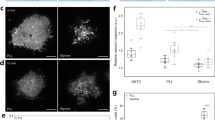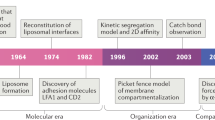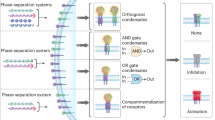Abstract
CONSIDERATIONS of membrane fluidity (see refs 1–5) have often involved schematic representations of the cell plasma membrane and underlying cytoskeletal structures3–5. But, although intended to show how microtubules, microfilaments and so on might interfere with the mobility of membrane components, such models have not been drawn to scale. Usually microtubules and microfilaments seem much smaller than the plasma membrane, whereas the reverse is true. Thus, it has not been possible to evaluate fully the relative importance of plasma membrane and cytoskeleton in influencing cell surface dynamics. I have therefore tried to draw these various elements to scale. Since the data come from heterogeneous sources (fibroblasts, muscle cells, amoeba, plant cells, epithelial cells and lymphocytes) it is clear that the organisation of the various structures represented here can only be hypothetical and does not correspond to a known structure in a given cell type.
This is a preview of subscription content, access via your institution
Access options
Subscribe to this journal
Receive 51 print issues and online access
$199.00 per year
only $3.90 per issue
Buy this article
- Purchase on Springer Link
- Instant access to full article PDF
Prices may be subject to local taxes which are calculated during checkout
Similar content being viewed by others
References
Singer, S. J., A. Rev. Biochem., 43, 805–833 (1974).
Perspectives in Membrane Biology (edit. by Estrada-O, S., and Gitler, C.), (Academic Press, London, 1974).
Nicolson, G. L., Biochim. biophys. Acta, 457, 57–108 (1976); 458, 1–71 (1976).
Edelman, G. M., Science, 192, 218–226 (1976).
Raff, M. C., Scient. Am. 234, 30–39 (1976).
Loor, F., in B and T Cells in Immune Recognition (edit. by Loor, F.,and Roelants, G. E.), (John Wiley, New York, in the press).
Caspar, D. L. D., Adv. Protein Chem., 18, 37–121 (1973).
Helper, P. K., and Palevitz, B. A., A. Rev. Pl. Physiol, 25, 309–362 (1974).
Pollard, T. D., and Weihing, R. R., C. R. C. Crit. Rev. Biochem., 2, 1–65 (1974).
Mooseker, M. S., and Tilney, L. G., J. Cell Biol., 67, 725–743 (1975).
Young, M., King, M. V., O'Hara, D. S., and Molberg, P. J., Cold Spring Harb. Symp. quant. Biol, 37, 65–76 (1973).
Author information
Authors and Affiliations
Rights and permissions
About this article
Cite this article
LOOR, F. Cell surface design. Nature 264, 272–273 (1976). https://doi.org/10.1038/264272a0
Received:
Accepted:
Issue Date:
DOI: https://doi.org/10.1038/264272a0
This article is cited by
-
Actin-containing matrix associated with the plasma membrane of murine tumour and lymphoid cells
Nature (1981)
-
The effect of agents influencing cytoskeletal elements upon the dielectrophoretic behavior of cultured epidermal cells
Journal of Biological Physics (1981)
-
The role of chromosomes in anaphase trigger and nuclear envelope activity in spindle formation
Chromosoma (1980)
-
Increased elongated and stabilized microtubules in psoriatic keratinocytes
Archives of Dermatological Research (1979)
Comments
By submitting a comment you agree to abide by our Terms and Community Guidelines. If you find something abusive or that does not comply with our terms or guidelines please flag it as inappropriate.



